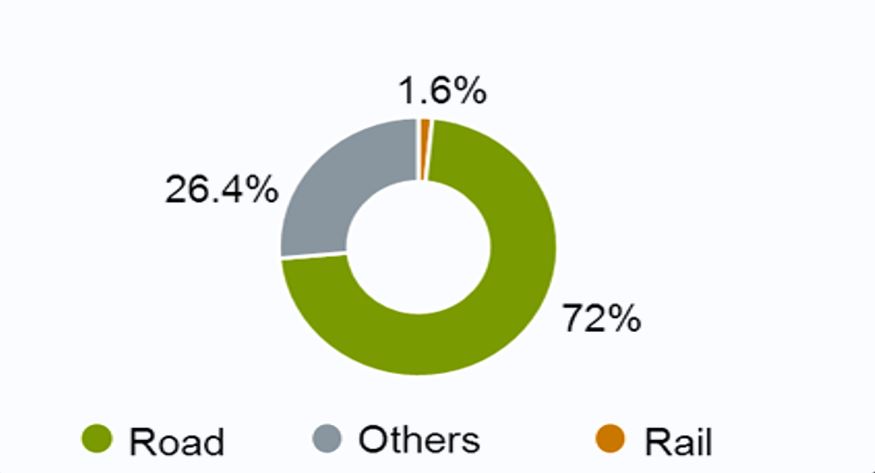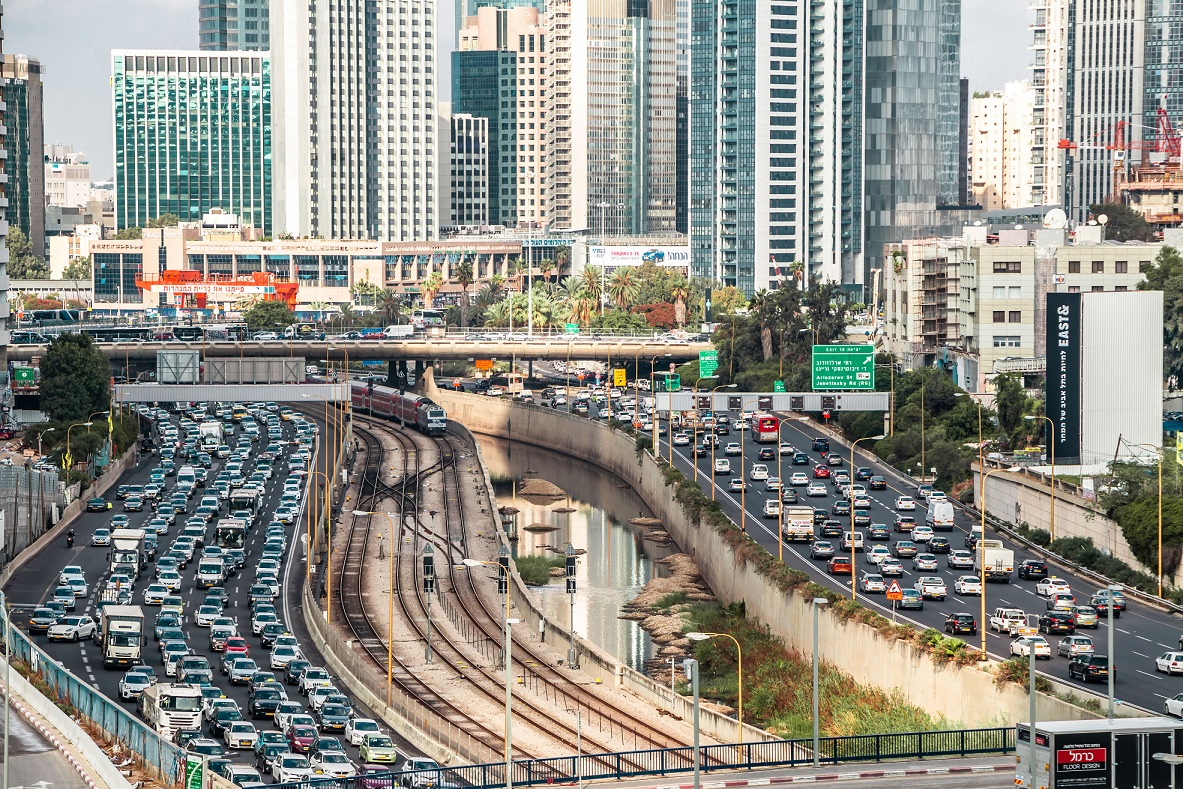Publications
INSS Insight No. 1619, July 13, 2022
Many studies have testified to the national-strategic importance of a state’s transportation system. The overall concept of transportation interfaces with many fields that are relevant to decision making on the national level relating to human life, quality of life, economy, housing prices, demography, hospital congestion, social aspects, distributive justice, air pollution, and efforts toward a greener world, as well as international relations. This article, which is based on insights from transportation studies and definitions of national security, contends that shaping public policy regarding the State of Israel’s transportation infrastructure must be an inseparable part of national security considerations.
Many studies written and published on the issue of transportation testify to this sector’s strategic-national importance. The overall concept of transportation interfaces with many aspects that are relevant to decision making on the national level – human life, quality of life, economy, housing prices, demographic distribution, hospital congestion, social aspects, distributive justice, air pollution, and efforts toward a greener world, as well as international relations.
Transportation and Human Life
Since 1948, over 33,000 people have been killed in traffic accidents in Israel. For the sake of comparison, the number of fallen soldiers from Israel's wars since 1890 is 24,000. A significant percentage of IDF casualties are also caused by traffic accidents. According to Israel Central Bureau of Statistics (CBS) data, there are an average of 300-400 traffic accident fatalities each year and about 18,000 people are injured, of whom about 2,000 are people with serious, life-changing injuries.
Air pollution is clearly directly connected to human life. According to the World Health Organization (WHO), air pollution in large urban blocs stems mainly from the use of private vehicles. The accompanying diagram, prepared by the WHO, charts the sources of air pollution in urban areas:

72 percent of all pollution is produced by road traffic, 1.6 percent by rail transport, and the rest from other polluters. That is, the vast majority is caused by transportation. In this context, data from the Ministry of Health published by the CBS that indicates that in recent years an annual average of 1,000 people died of air pollution.
These figures are correlated directly with public policy, which has created a problematic equation of the excessive use of private vehicles on Israel's roads in general and in urban areas in particular. When we examine this figure in comparison with the WHO, we can conclude that the majority of casualties from air pollution are the result of road traffic. This figure is also reflected in a diagram that charts the balance between public transportation, which reduces the use of private vehicles, and the situation in practice.

Another aspect of the government's responsibility for its citizens on the national level is protection of the home front. In Israel’s Gush Dan or central region, there are almost no public protection systems, and each time an warning siren is heard, passersby crowd into the hallways of random buildings. In contrast, as early as World War II, London's civilians found shelter in the Tube's tunnels, while in the current fighting between Russia and Ukraine, Ukrainian civilians flee to the tunnels of the subway for protection. In 2003, rail transportation researcher Mark Ovenden published a comprehensive study on subway systems around the world and already then noted dozens of countries that promoted the development of subways and made sure to protect them with measures that provide shelter to residents in case of the use of unconventional weapons (Moscow, Tokyo, Washington, and more).
Regarding traffic accidents, is the high toll in human lives a necessary condition for progress? No country has reached a state of zero traffic accident fatalities, but in many countries that have shaped and implemented public policy and reforms in transportation, the damage to human life has been reduced by dozens of percentage points. Without a doubt, the provision of a public product as vital as effective and functioning public transportation changes the balance scales of human life. For example, the metro system in Paris provides about 2 billion rides per year, and in the past 50 years not a single passenger has been killed.
Regarding air pollution, decisions on the national level in Israel have determined that in the Tel Aviv region there will not be rail transportation, and to this day no mass transit system operating in Tel Aviv is based on trains. As a result, the air pollution in the Tel Aviv region harms people's health. On the website of the International Association of Public Transport (UITP) – an international organization comprising states, rail companies, and municipal managements and conducts studies on urban transportation – there are comparisons of air pollution levels. An example relevant to this issue: The average level of air pollution in Berlin is about half of the level of air pollution in the Tel Aviv metropolitan area. In turn, the number of casualties of pollution drops in cities that ensure proper public transportation.
Transportation in a Strategic Context
States use air and sea transportation to strengthen their foreign relations and their economies – for imports and exports goods, as well as tourism. In Israel, about 99 percent of all cargo that enters and exits Israel goes through the seaports. One of the first measures surrounding the Abraham Accords was establishing air transportation.
For land transportation as well, the strategic context is clear. Immediately after the fall of the Iron Curtain, one of the first investments was adapting the railways between Eastern and Western Europe to enable a contiguous land link between the regions. From the extensive literature published on the Israeli-Palestinian political process, as part of the American mediation a proposal was made to connect the Gaza Strip and Hebron in the West Bank via a railway. In discussions on possible arrangements between Israel and Syria, including the demilitarization of the Golan Heights, an American proposal was made to create a network of railways that would help to move Israeli forces to the north quickly, if necessary.
Over the years, rail transportation has been an important element in military logistics, from the American Civil War to World War I and II. Likewise today. A single locomotive can move an entire tank battalion – including all the elements – without a need for tank transport drivers and without congestion on the roads. Proof can be found on the website of the US Army in the field of logistics: the current photograph displays military forces loaded on train cars. This is how they move throughout the continent today.

Despite the logistical problems expected in times of emergency, the IDF has not yet made a decision to use freight trains to move forces. Significantly increasing the volume of railways in Israel would also enable the defense forces to use trains to move troops.
The Impact of Transportation on the Economy and Society
An extensive and efficient public transportation system is the right way to address the need for access and the problems of congestion, safety, and air pollution, and it is an essential element of social and economic growth. An economic analysis of the direct and indirect costs of road congestion, such as the Ministry of Finance's estimate made by the Ministry's Budgets Department in early 2018, showed a level of damage of about 35 billion NIS per year. This estimate also forecast that by 2040 the damage would reach about 70 billion NIS per year.
In 2020, the Ministry of Transport budget was 28 billion NIS – less than half of the Ministry of Defense budget. Increasing the transportation budget could considerably reduce the damage from road congestion. Transportation saves the country energy: an electric train on an intercity route can carry 1,500 passengers; in terms of the State of Israel this means almost 1,500 fewer cars on the road. Electric rail transportation uses about a tenth of the energy needed for vehicle transportation with the same passenger capacity. Furthermore, rail transportation saves land: the width of railways on intercity lines is about 9 meters, while the width of a divided highway ranges from 30 to 40 meters. The Qessem interchange, for example, covers an area of about 30,000 square meters, while a rail interchange includes 70 square meters.

Therefore, effective public transportation would enable better utilization of land by reducing the area necessary for roads and parking. The importance of land to national security in Israel is clear.
Effective transportation also has an important social role, as it is meant to enable mobility to places of employment and to public services, including medical centers, and to provide protection centers in the home front and in urban blocs to those unable to rely on private vehicles. For those who have a private vehicle, its operation and cost are a central component of the cost of living.
Furthermore, transportation affects demographic distribution. Around the world, rail transportation provides intercity movement at speeds of 250 to 350 km/h. In a small country such as Israel, a fast trip to the urban blocs would cancel the concepts of development towns or periphery. Hence the conclusion that if there were better transportation access throughout the country, the population could be distributed over extensive areas without compromising on employment, and housing prices would be reduced.
In conclusion: If a central element of national security includes the country protecting its citizens and residents, then transportation is undoubtedly part of this equation The main impacts of transportation in the context of national security are on human life, the economy, the cost of living, demographic decentralization, and quality of life, all with strategic-military implications. Consequently, the discussion on improving transportation in Israel, with its numerous facets, is important to any national security discourse.



